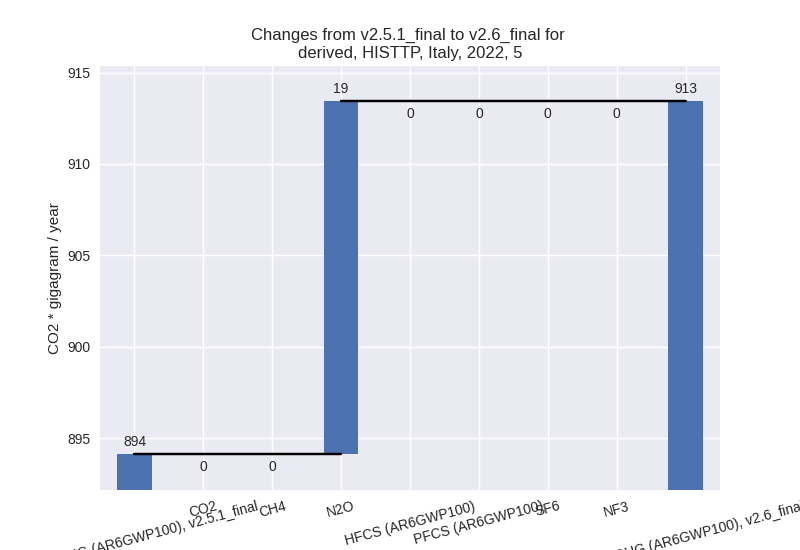Changes in PRIMAP-hist v2.6_final compared to v2.5.1_final for Italy
2024-09-24
Johannes Gütschow
Change analysis for Italy for PRIMAP-hist v2.6_final compared to v2.5.1_final
Overview over emissions by sector and gas
The following figures show the aggregate national total emissions excluding LULUCF AR6GWP100 for the country reported priority scenario. The dotted linesshow the v2.5.1_final data.
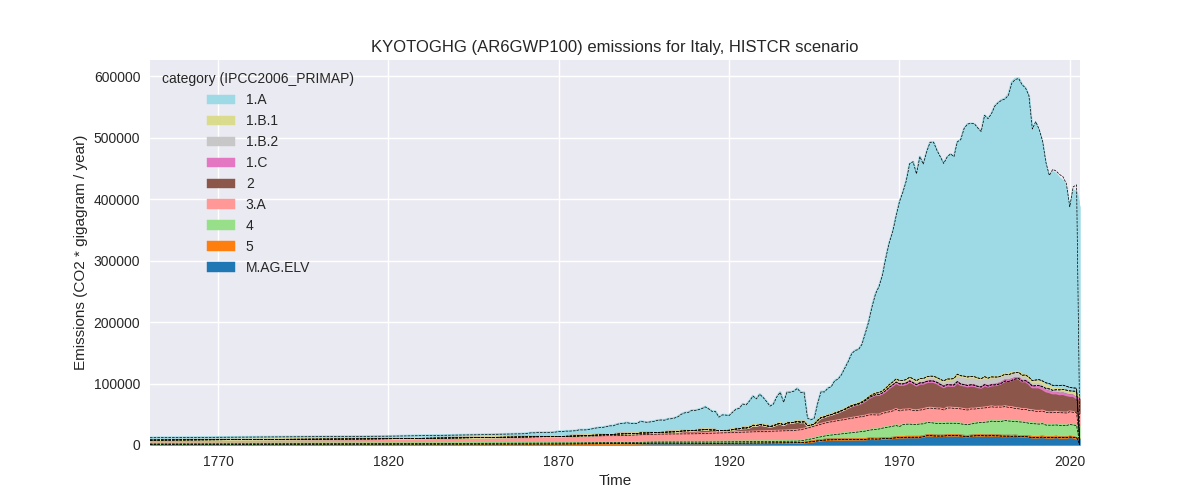
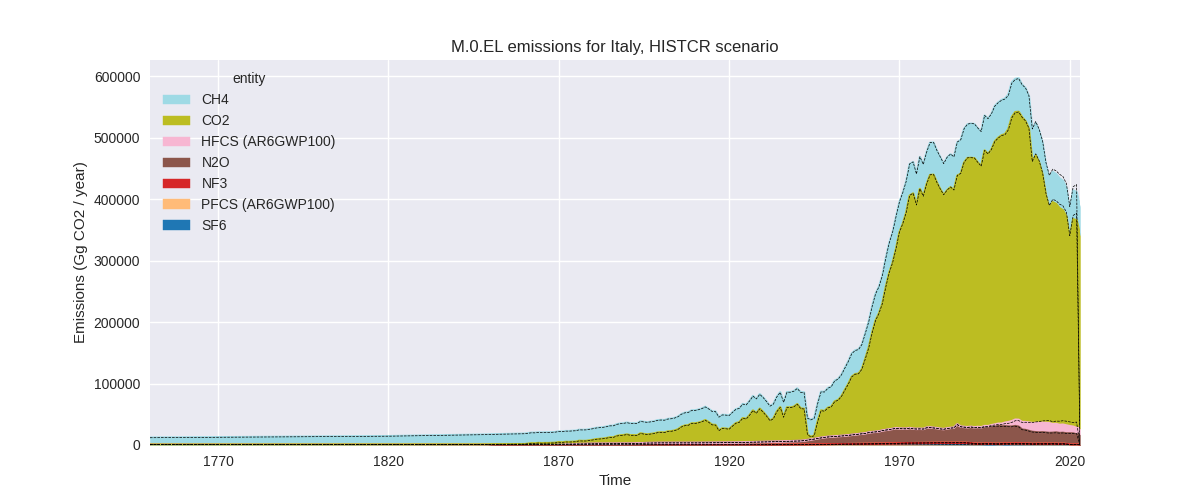
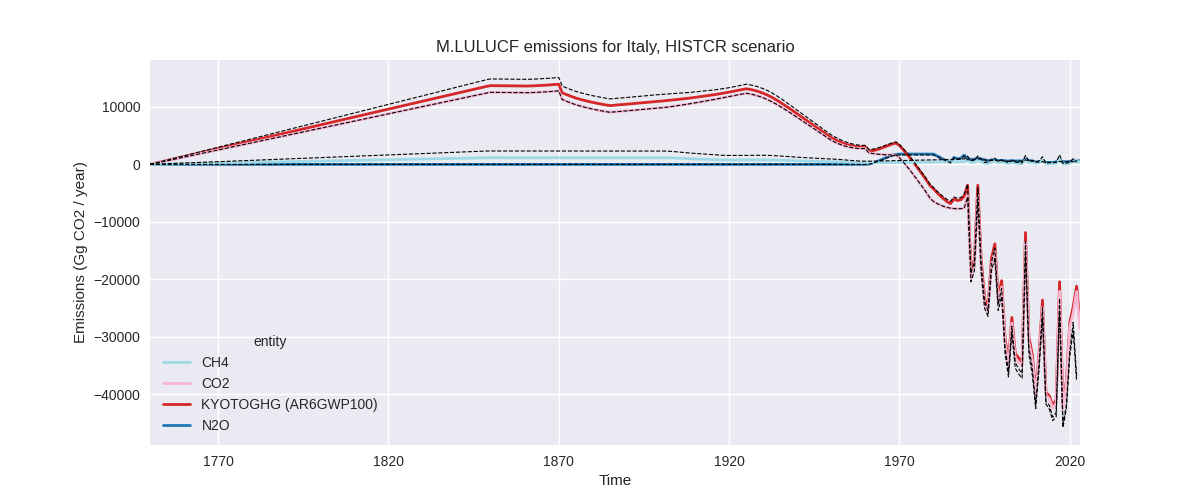
The following figures show the aggregate national total emissions excluding LULUCF AR6GWP100 for the third party priority scenario. The dotted linesshow the v2.5.1_final data.

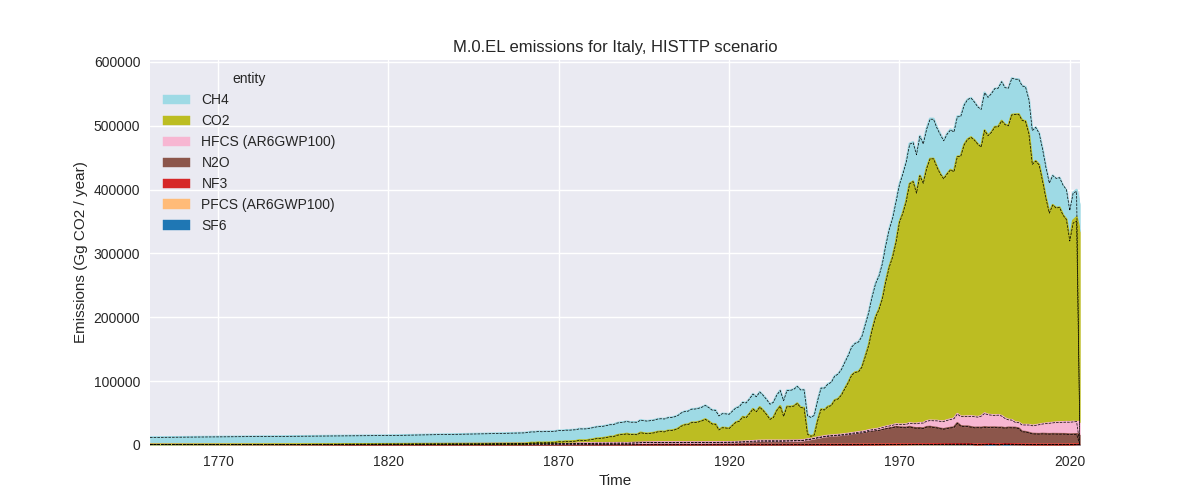
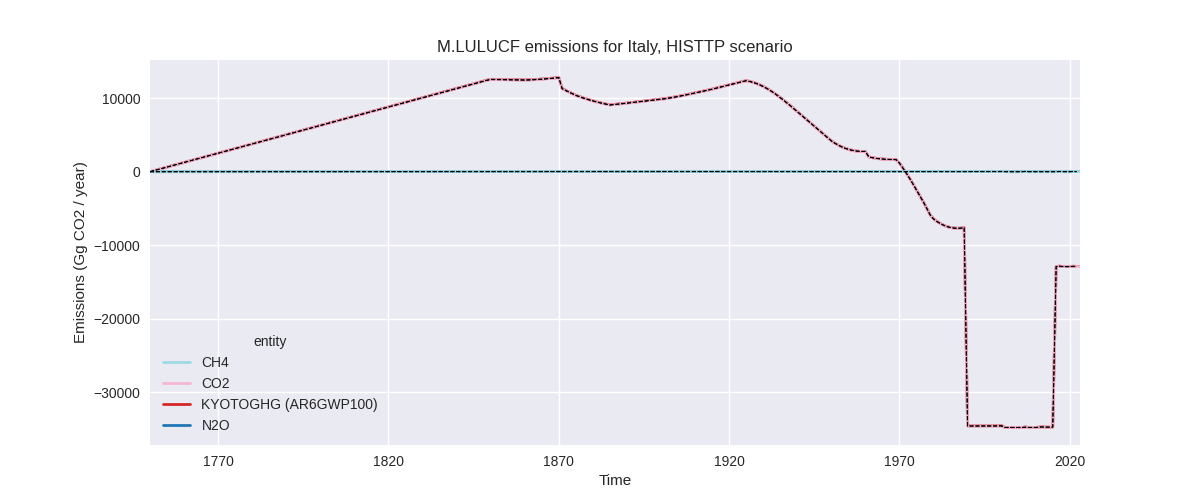
Overview over changes
In the country reported priority scenario we have the following changes for aggregate Kyoto GHG and national total emissions excluding LULUCF (M.0.EL):
- Emissions in 2022 have changed by -2.9%% (-12362.16 Gg CO2 / year)
- Emissions in 1990-2022 have changed by -0.5%% (-2366.77 Gg CO2 / year)
In the third party priority scenario we have the following changes for aggregate Kyoto GHG and national total emissions excluding LULUCF (M.0.EL):
- Emissions in 2022 have changed by 0.6%% (2444.87 Gg CO2 / year)
- Emissions in 1990-2022 have changed by -0.0%% (-163.63 Gg CO2 / year)
Most important changes per scenario and time frame
In the country reported priority scenario the following sector-gas combinations have the highest absolute impact on national total KyotoGHG (AR6GWP100) emissions in 2022 (top 5):
- 1: 2, HFCS (AR6GWP100) with -8083.02 Gg CO2 / year (-43.2%)
- 2: 2, CO2 with -1738.90 Gg CO2 / year (-11.7%)
- 3: M.AG.ELV, N2O with -1267.38 Gg CO2 / year (-12.5%)
- 4: 4, CH4 with 641.43 Gg CO2 / year (3.6%)
- 5: 1.B.2, CH4 with -459.44 Gg CO2 / year (-14.1%)
In the country reported priority scenario the following sector-gas combinations have the highest absolute impact on national total KyotoGHG (AR6GWP100) emissions in 1990-2022 (top 5):
- 1: 2, HFCS (AR6GWP100) with -1738.95 Gg CO2 / year (-16.4%)
- 2: 2, CO2 with -1010.35 Gg CO2 / year (-4.5%)
- 3: M.AG.ELV, N2O with 201.65 Gg CO2 / year (1.8%)
- 4: 1.A, CO2 with 186.55 Gg CO2 / year (0.0%)
- 5: 2, PFCS (AR6GWP100) with -43.92 Gg CO2 / year (-2.8%)
In the third party priority scenario the following sector-gas combinations have the highest absolute impact on national total KyotoGHG (AR6GWP100) emissions in 2022 (top 5):
- 1: 1.A, CO2 with 6723.16 Gg CO2 / year (2.3%)
- 2: 4, CH4 with -3291.73 Gg CO2 / year (-21.8%)
- 3: 2, HFCS (AR6GWP100) with -1100.69 Gg CO2 / year (-5.5%)
- 4: 2, SF6 with 194.72 Gg CO2 / year (36.4%)
- 5: 1.B.3, CH4 with -136.48 Gg CO2 / year (-22.4%)
In the third party priority scenario the following sector-gas combinations have the highest absolute impact on national total KyotoGHG (AR6GWP100) emissions in 1990-2022 (top 5):
- 1: 4, CH4 with -471.92 Gg CO2 / year (-2.2%)
- 2: 1.A, CO2 with 311.88 Gg CO2 / year (0.1%)
- 3: 2, HFCS (AR6GWP100) with -33.35 Gg CO2 / year (-0.2%)
- 4: 5, N2O with 8.07 Gg CO2 / year (0.5%)
- 5: 2, SF6 with 5.90 Gg CO2 / year (1.0%)
Notes on data changes
Here we list notes explaining important emissions changes for the country. ’' means that the following text only applies to the TP time series, while means that it only applies to the CR scenario. Otherwise the note applies to both scenarios.
- 2024 EEA data has been added.
- HFCs data is much lower in EEA2024 than in CRF2023 after 2010 leading to much lower 2022 f-gas emissions and lower cumulative emissions in the CR scenario. The origin of the changes is mainly sector 1.F.1 (Refrigeration and air conditioning).
- The lower cement CO2 emissions in 2022 are due to a decline in EEA2024 while Andrew cement data shows constant emissions.
- Lower N2O in M.AG.ELV in 2022 comes from a decline in emissions that is not as strong in FAOstat data use in v2.5.1. The TP scenario shows changes for 2022 for several sectors and gases which are due to changes in input data (EI2024 for 1.A, 1.B.2, CO2) and replacement of numerical trends with actual data (f-gases, CH4 in 1.B.3). cumulative emissions in the third party priority scenario only show very small changes.
- Changes in sectors 4 and 5 in the TP scenario are due to the removal of FAOSTAT data.
Changes by sector and gas
For each scenario and time frame the changes are displayed for all individual sectors and all individual gases. In the sector plot we use aggregate Kyoto GHGs in AR6GWP100. In the gas plot we usenational total emissions without LULUCF. ## country reported scenario
2022
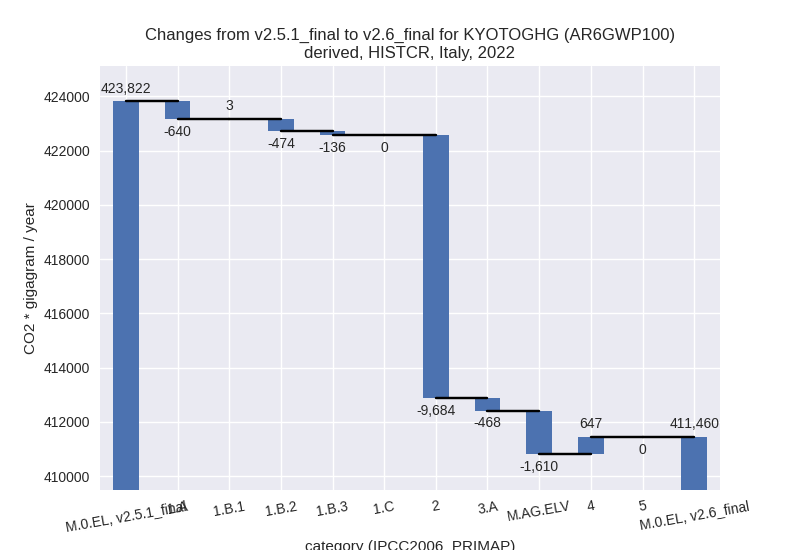
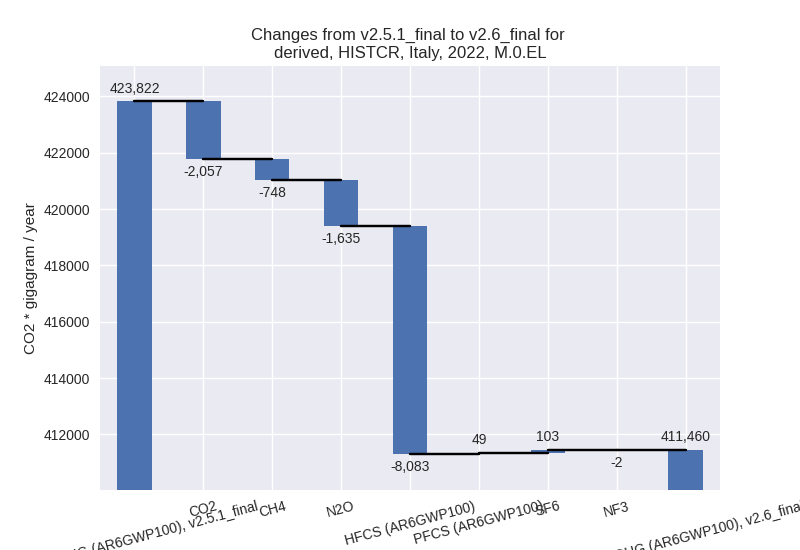
1990-2022
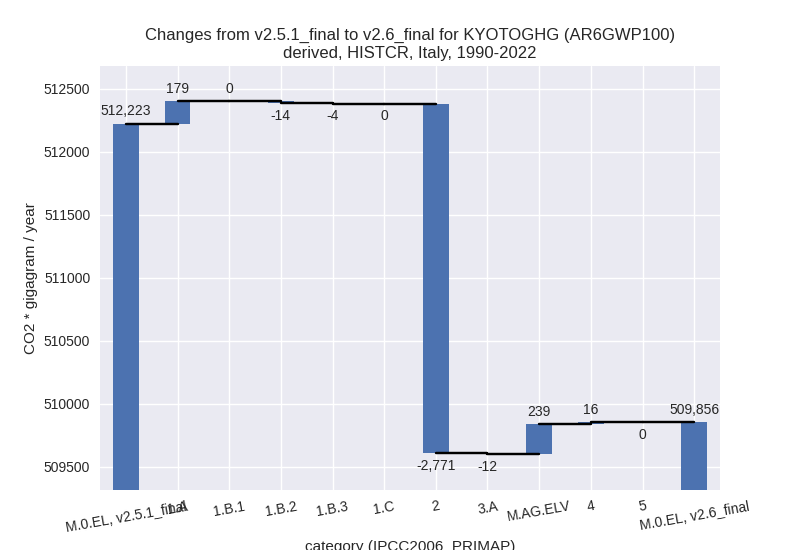
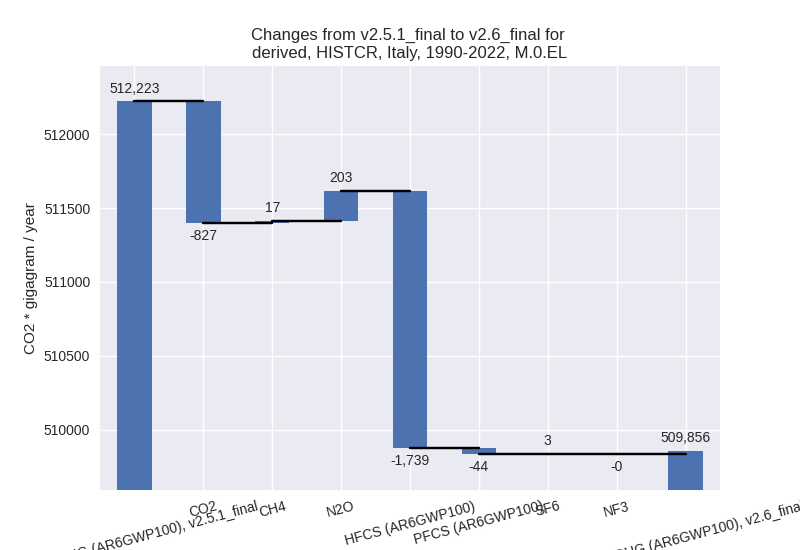
third party scenario
2022

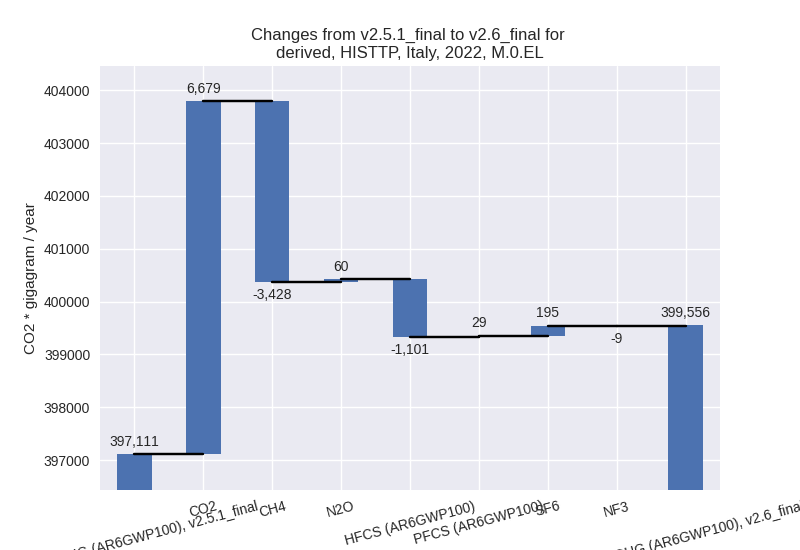
1990-2022
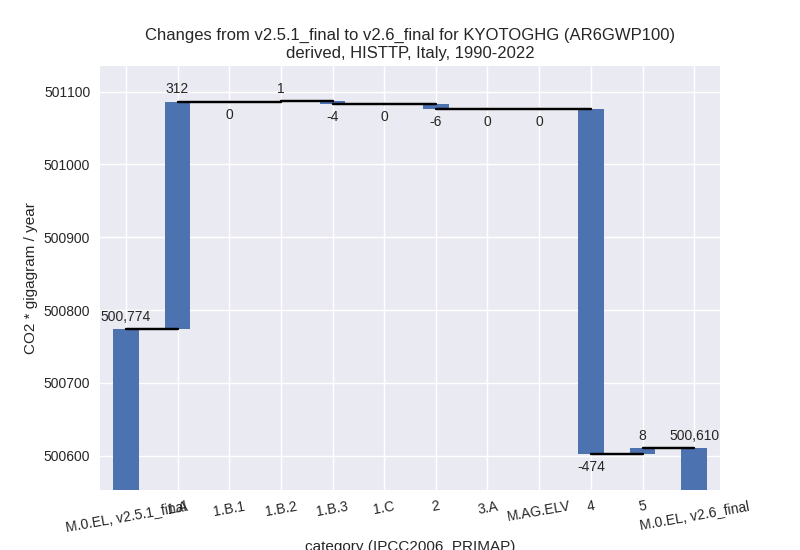
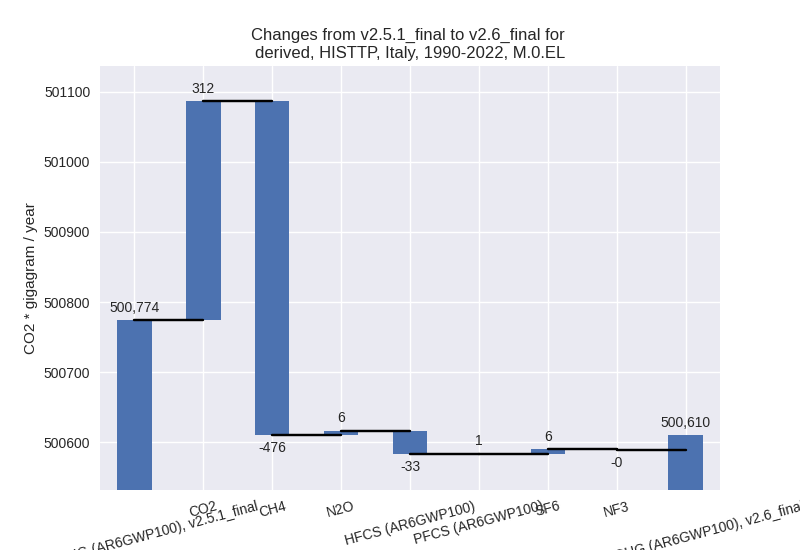
Detailed changes for the scenarios:
country reported scenario (HISTCR):
Most important changes per time frame
For 2022 the following sector-gas combinations have the highest absolute impact on national total KyotoGHG (AR6GWP100) emissions in 2022 (top 5):
- 1: 2, HFCS (AR6GWP100) with -8083.02 Gg CO2 / year (-43.2%)
- 2: 2, CO2 with -1738.90 Gg CO2 / year (-11.7%)
- 3: M.AG.ELV, N2O with -1267.38 Gg CO2 / year (-12.5%)
- 4: 4, CH4 with 641.43 Gg CO2 / year (3.6%)
- 5: 1.B.2, CH4 with -459.44 Gg CO2 / year (-14.1%)
For 1990-2022 the following sector-gas combinations have the highest absolute impact on national total KyotoGHG (AR6GWP100) emissions in 1990-2022 (top 5):
- 1: 2, HFCS (AR6GWP100) with -1738.95 Gg CO2 / year (-16.4%)
- 2: 2, CO2 with -1010.35 Gg CO2 / year (-4.5%)
- 3: M.AG.ELV, N2O with 201.65 Gg CO2 / year (1.8%)
- 4: 1.A, CO2 with 186.55 Gg CO2 / year (0.0%)
- 5: 2, PFCS (AR6GWP100) with -43.92 Gg CO2 / year (-2.8%)
Changes in the main sectors for aggregate KyotoGHG (AR6GWP100) are
- 1: Total sectoral emissions in 2022 are 335235.05 Gg CO2 / year which is 81.5% of M.0.EL emissions. 2022 Emissions have changed by -0.4% (-1247.40 Gg CO2 / year). 1990-2022 Emissions have changed by 0.0% (161.35 Gg CO2 / year).
- 2: Total sectoral emissions in 2022 are 25210.66 Gg
CO2 / year which is 6.1% of M.0.EL emissions. 2022 Emissions have
changed by -27.8% (-9683.85 Gg CO2 /
year). 1990-2022 Emissions have changed by -7.0% (-2771.06 Gg CO2 / year). For 2022
the changes per gas
are:
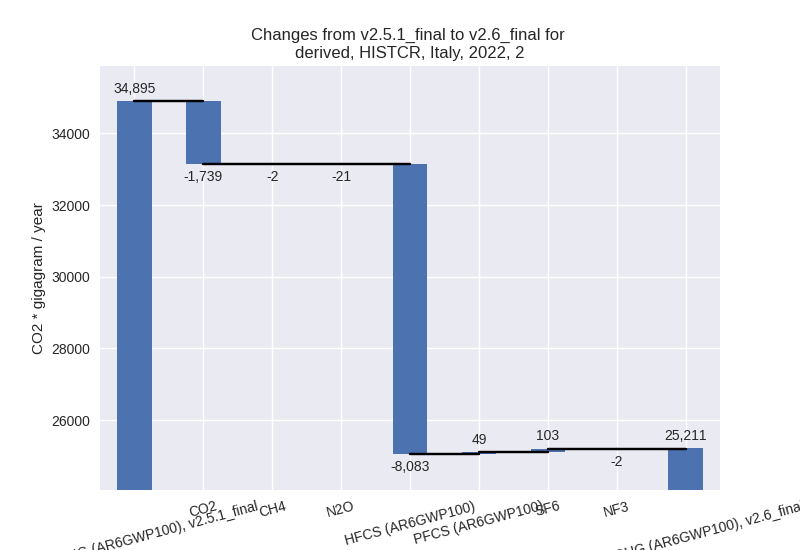
For 1990-2022 the changes per gas are: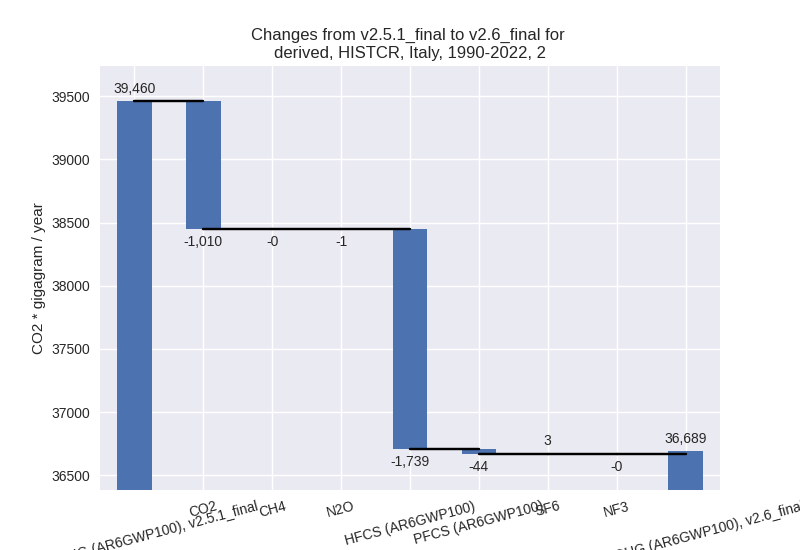
- M.AG: Total sectoral emissions in 2022 are 30982.12
Gg CO2 / year which is 7.5% of M.0.EL emissions. 2022 Emissions have
changed by -6.3% (-2078.33 Gg CO2 /
year). 1990-2022 Emissions have changed by 0.6% (226.86 Gg CO2 / year). For 2022 the
changes per gas
are:

The changes come from the following subsectors:- 3.A: Total sectoral emissions in 2022 are 20323.86
Gg CO2 / year which is 65.6% of category M.AG emissions. 2022 Emissions
have changed by -2.3% (-468.38 Gg
CO2 / year). 1990-2022 Emissions have changed by -0.1% (-12.49 Gg CO2 / year). For 2022 the
changes per gas
are:
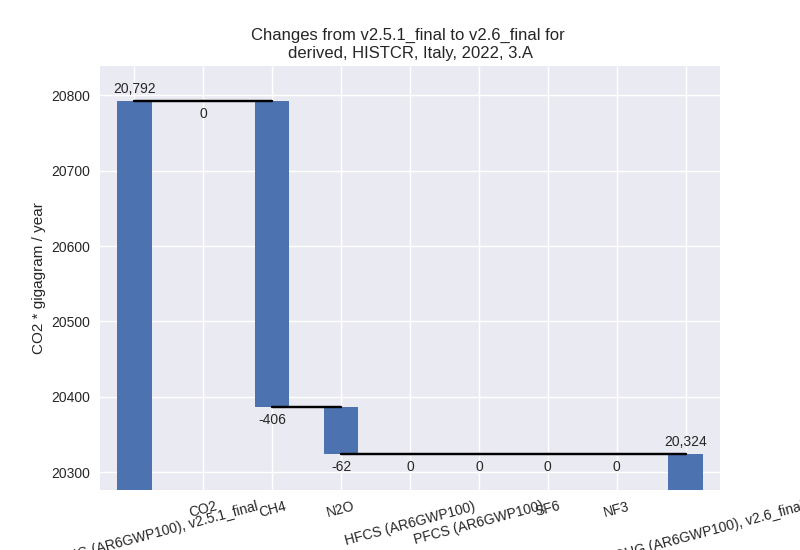
There is no subsector information available in PRIMAP-hist. - M.AG.ELV: Total sectoral emissions in 2022 are
10658.26 Gg CO2 / year which is 34.4% of category M.AG emissions. 2022
Emissions have changed by -13.1%
(-1609.96 Gg CO2 / year). 1990-2022 Emissions have changed by 1.8% (239.35 Gg CO2 / year). For 2022 the
changes per gas
are:
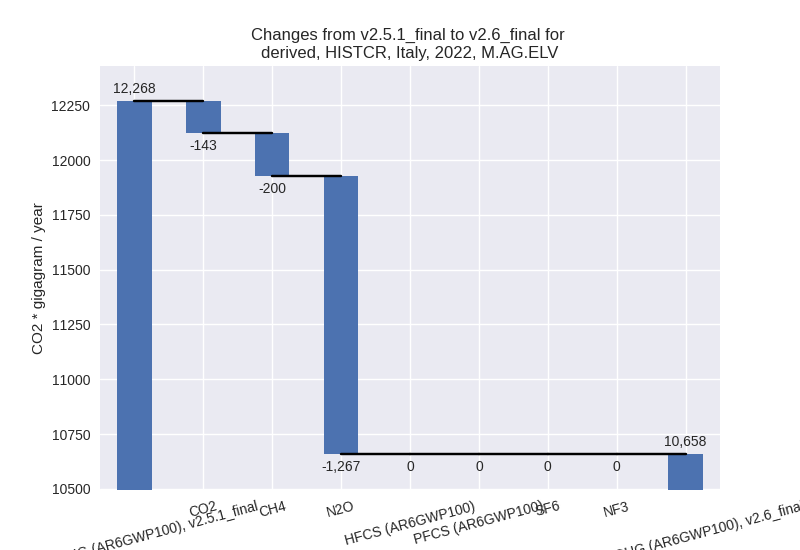
There is no subsector information available in PRIMAP-hist.
- 3.A: Total sectoral emissions in 2022 are 20323.86
Gg CO2 / year which is 65.6% of category M.AG emissions. 2022 Emissions
have changed by -2.3% (-468.38 Gg
CO2 / year). 1990-2022 Emissions have changed by -0.1% (-12.49 Gg CO2 / year). For 2022 the
changes per gas
are:
- 4: Total sectoral emissions in 2022 are 20032.18 Gg
CO2 / year which is 4.9% of M.0.EL emissions. 2022 Emissions have
changed by 3.3% (647.42 Gg CO2 /
year). 1990-2022 Emissions have changed by 0.1% (16.08 Gg CO2 / year). For 2022 the
changes per gas
are:
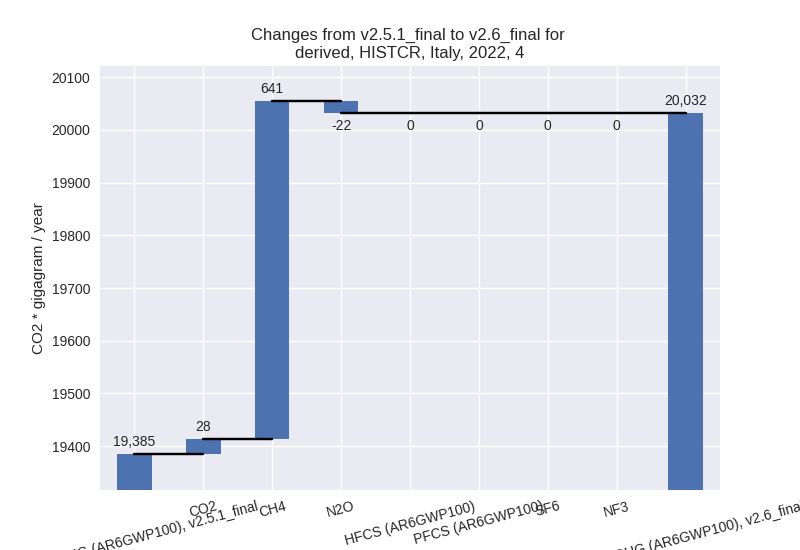
- 5: No data
third party scenario (HISTTP):
Most important changes per time frame
For 2022 the following sector-gas combinations have the highest absolute impact on national total KyotoGHG (AR6GWP100) emissions in 2022 (top 5):
- 1: 1.A, CO2 with 6723.16 Gg CO2 / year (2.3%)
- 2: 4, CH4 with -3291.73 Gg CO2 / year (-21.8%)
- 3: 2, HFCS (AR6GWP100) with -1100.69 Gg CO2 / year (-5.5%)
- 4: 2, SF6 with 194.72 Gg CO2 / year (36.4%)
- 5: 1.B.3, CH4 with -136.48 Gg CO2 / year (-22.4%)
For 1990-2022 the following sector-gas combinations have the highest absolute impact on national total KyotoGHG (AR6GWP100) emissions in 1990-2022 (top 5):
- 1: 4, CH4 with -471.92 Gg CO2 / year (-2.2%)
- 2: 1.A, CO2 with 311.88 Gg CO2 / year (0.1%)
- 3: 2, HFCS (AR6GWP100) with -33.35 Gg CO2 / year (-0.2%)
- 4: 5, N2O with 8.07 Gg CO2 / year (0.5%)
- 5: 2, SF6 with 5.90 Gg CO2 / year (1.0%)
Changes in the main sectors for aggregate KyotoGHG (AR6GWP100) are
- 1: Total sectoral emissions in 2022 are 313571.29
Gg CO2 / year which is 78.5% of M.0.EL emissions. 2022 Emissions have
changed by 2.1% (6539.94 Gg CO2 /
year). 1990-2022 Emissions have changed by 0.1% (308.69 Gg CO2 / year). For 2022 the
changes per gas
are:
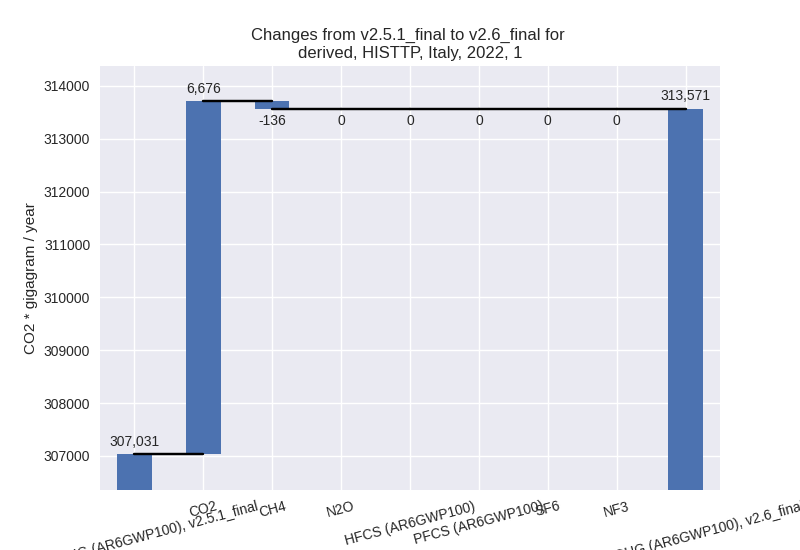
The changes come from the following subsectors:- 1.A: Total sectoral emissions in 2022 are 308769.03
Gg CO2 / year which is 98.6% of category 1 emissions. 2022 Emissions
have changed by 2.2% (6723.16 Gg CO2
/ year). 1990-2022 Emissions have changed by 0.1% (311.88 Gg CO2 / year). For 2022 the
changes per gas
are:
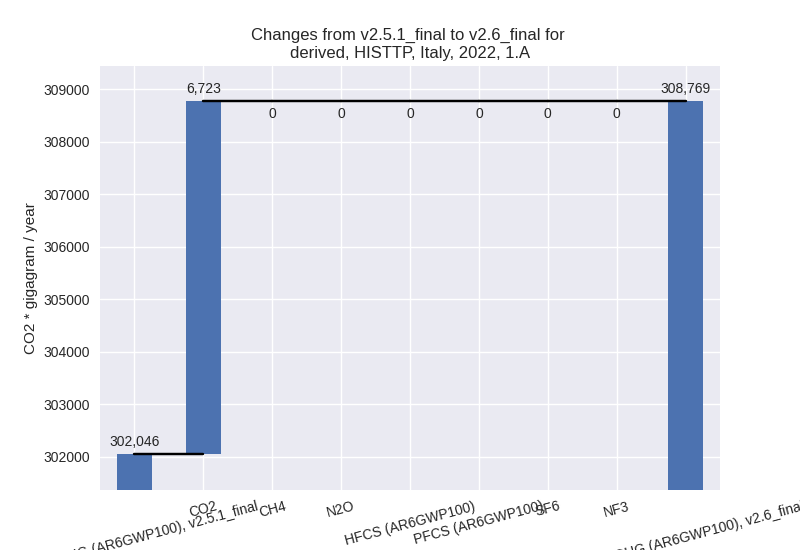
There is no subsector information available in PRIMAP-hist. - 1.B.1: Total sectoral emissions in 2022 are 287.24 Gg CO2 / year which is 0.1% of category 1 emissions. 2022 Emissions have changed by 0.0% (0.00 Gg CO2 / year). 1990-2022 Emissions have changed by 0.0% (0.00 Gg CO2 / year).
- 1.B.2: Total sectoral emissions in 2022 are 4041.67 Gg CO2 / year which is 1.3% of category 1 emissions. 2022 Emissions have changed by -1.1% (-46.74 Gg CO2 / year). 1990-2022 Emissions have changed by 0.0% (0.84 Gg CO2 / year).
- 1.A: Total sectoral emissions in 2022 are 308769.03
Gg CO2 / year which is 98.6% of category 1 emissions. 2022 Emissions
have changed by 2.2% (6723.16 Gg CO2
/ year). 1990-2022 Emissions have changed by 0.1% (311.88 Gg CO2 / year). For 2022 the
changes per gas
are:
- 2: Total sectoral emissions in 2022 are 36321.43 Gg
CO2 / year which is 9.1% of M.0.EL emissions. 2022 Emissions have
changed by -2.3% (-866.17 Gg CO2 /
year). 1990-2022 Emissions have changed by -0.0% (-6.33 Gg CO2 / year). For 2022 the
changes per gas
are:
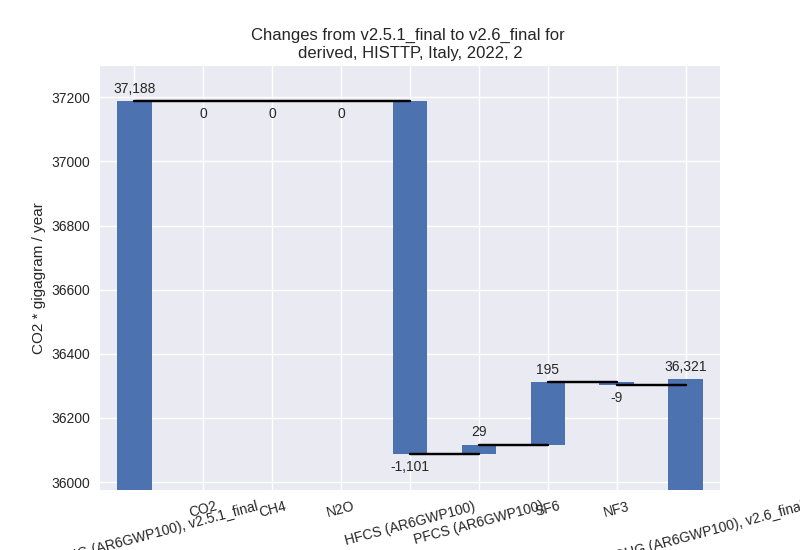
- M.AG: Total sectoral emissions in 2022 are 35145.00 Gg CO2 / year which is 8.8% of M.0.EL emissions. 2022 Emissions have changed by 0.0% (0.00 Gg CO2 / year). 1990-2022 Emissions have changed by 0.0% (0.00 Gg CO2 / year).
- 4: Total sectoral emissions in 2022 are 13604.86 Gg
CO2 / year which is 3.4% of M.0.EL emissions. 2022 Emissions have
changed by -19.3% (-3248.21 Gg CO2 /
year). 1990-2022 Emissions have changed by -2.0% (-474.06 Gg CO2 / year). For 2022
the changes per gas
are:
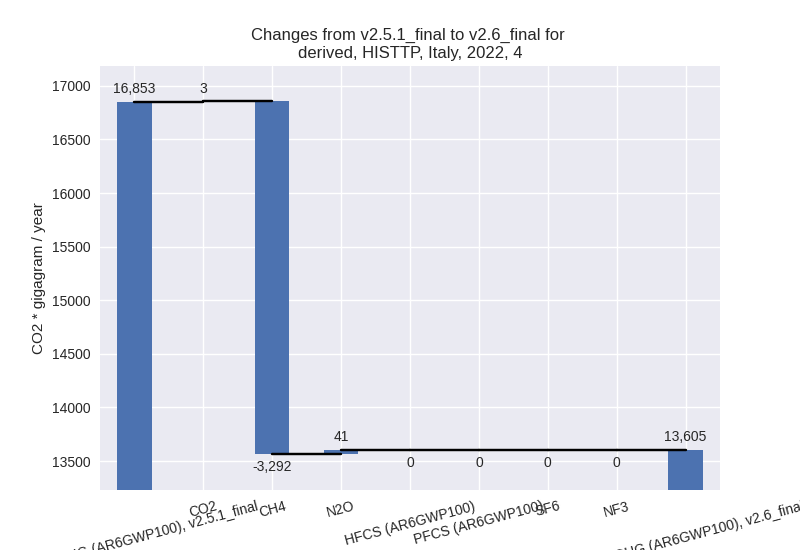
For 1990-2022 the changes per gas are: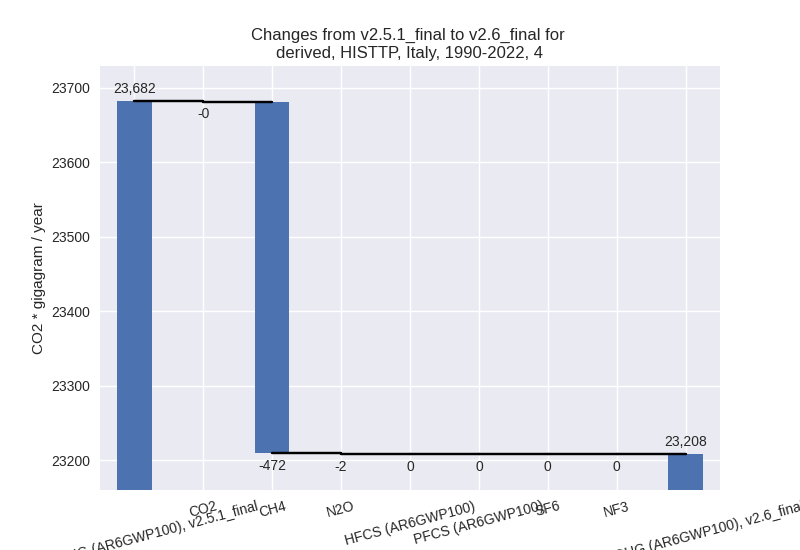
- 5: Total sectoral emissions in 2022 are 913.43 Gg
CO2 / year which is 0.2% of M.0.EL emissions. 2022 Emissions have
changed by 2.2% (19.31 Gg CO2 /
year). 1990-2022 Emissions have changed by 0.5% (8.07 Gg CO2 / year). For 2022 the
changes per gas
are:
